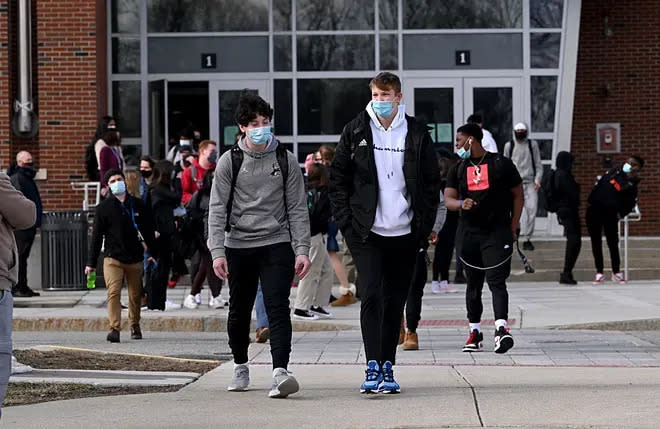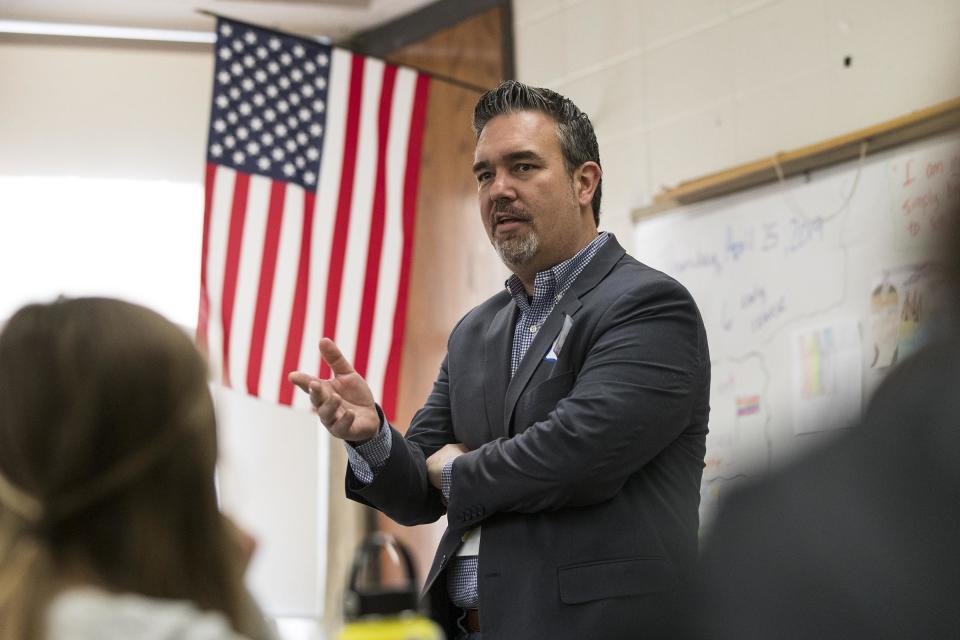Fewer students are taking the SAT. Why MetroWest educators aren't worried
The number of students taking the SAT has declined in recent years, but educators and college officials say that's not necessarily a bad thing.
The test, which in the past has been called "Scholastic Aptitude Test" and "Scholastic Assessment Test" before becoming simply SAT, is an entrance exam administered by the College Board and traditionally used by colleges and universities to make admissions decisions. For most of its 97-year history, it has had two components, verbal and mathematical, each of which is scored on a range from 200 to 800.
Iris Godes, dean of strategic enrollment at Framingham State University, told the Daily News that historically, Massachusetts state college requirements for incoming students included a minimum grade point average for their high school studies and "some expectation of the SAT scores.” She said there was often a "grid" where students could use their SAT scores and grade point averages to estimate their chances of getting into a college.

'Deviant process': Advocates educate families on how to opt out of upcoming MCAS
But in the years leading up to the pandemic, some colleges began making standardized tests optional. That's now the case for FSU and the rest of University of Massachusetts state college system.
“Research shows that results were not the best indicator for success,” Godes said. “It's (test-optional admissions) much fairer for students who face challenges like students with learning disabilities, students that speak a different language. The SAT wasn’t written to reflect (different) cultures."
Then there's the impact of COVID-19.
During the 2019-20 school year, which was interrupted in mid-March due to the pandemic, SAT participation was cut by nearly half, according to the state's Department of Elementary and Secondary Education. Coming out of the pandemic, numbers in some communities have returned close to pre-pandemic years. But in others, they've remained low.
Educators say the standardized test isn't an indicator of success
In Framingham, 496 SATs were taken — the vast majority of them by 11th and 12th graders — during the 2016-17 school year. Six years later, in 2022-23, there were 339 SATs taken in the city — a nearly one-third decline.
“I know that with the pandemic, a lot of colleges shifted away from requiring the SATs, because students couldn’t physically take the exam," said Framingham Superintendent of Schools Robert Tremblay. "I think that became a line in the sand for a lot of students and for colleges.”
'Significant first step': Framingham school approved for building authority's eligibilty pipeline
Tremblay said he doesn’t believe SAT scores are a fair predictor of a student's future success.
“Personally, I don’t remember exactly what I got on my SAT score in the '90s," he said. "Sitting here, four degrees later and having what I would hope is considered a reputable job as a school superintendent, did my SAT score really predict that? I don’t think so. The truth is, I went to Boston University for my undergrad. Would my SAT score be good enough to get into BU today? Probably not.”
Tremblay said he “definitely" believes students from higher-income families take the SATs at a higher rate.
"Those families can not only pay for the test, they can pay for private classes and tutors that can help with the exam,” he said. “If you come from a family that is just scraping by, you are not going to get any of that, and it’s not a level playing field.”

In Milford, the drop in the number of SATs taken over the same six-year period was even more sharp — 285 SATs were taken during 2016-17, and just 143 — barely half the first figure — in 2022-23.
Milford High School Principal Josh Otlin pointed to two reasons behind the declining numbers: fewer colleges require the scores and changes in student demographics. He said that in Milford, the percentage of students going to four-year colleges is declining, including those seeking to get into selective schools.
“We have a number of students growing up in poverty, so college is almost completely out of the question," Otlin said. "We also serve a number of undocumented students. The obstacles of attending college are enormous with the fact that they can’t get federal loans."
Wealth disparities play into taking the SAT
Tremblay said he believes SAT scores generally favor students from wealthier backgrounds, with families who have the means to contribute to tools that can provide better scores. In Milford, Otlin said the biggest determinant of college success is household income.
In wealthier communities, the number of SAT tests taken has returned closer to pre-pandemic years than in communities with lower median household incomes. In addition, students in wealthier communities usually score higher than students in communities with lower incomes.
'Excited to move forward': Milford wins key vote in its goal to rehab, or replace, its high school
"There’s all this SAT prep, you could spend a lot of money to be more successful at taking it," Godes said. “You could also have enough money to take it multiple times, so if you’re lower income, you went in there with very little preparation. Wealthier students in communities like Franklin, Wellesley and Wayland have a much higher income to pay for a tutor or a college councilor."
For example, in Wellesley, a community with a median household income of more than $250,000, according to Census.gov, 391 SATs were taken in 2016-17; six years later, in 2022-23, that number was 330, down a more modest 15.6%.
Students at Wellesley High School are encouraged to take the SAT, according to Principal Jamie Chisum. He estimates that 80% of colleges are now test optional and 97% of students at Wellesley High School pursue higher education.
“I think the numbers are steady, we saw a slight dip during COVID but they’ve come back,” Chisum said. In the 2019-20 school year, only 179 SATs were taken. But it was back up to 337 the following year, on par with pre-pandemic levels.
Chisum pointed out that the SAT data on the DESE website, where the Daily News obtained the data, does not include enrollment data, and that Wellesley's student population has decreased. During the 2016-17 school year, 1,512 students were enrolled in grades 9-12 in Wellesley, according to DESE data. In 2022-23, that number dropped 6.6%, to 1,412.
Despite the declines in both tests taken and enrollment, median scores have remained largely the same for Wellesley and Milford. For Milford, this is because of the profile of students taking the test inclides those who are applying to college, according to Otlin.
As for the scores in Wellesley, Chisum said it's hard to say.
"I think our kids work hard. They come from families that value education and I think it trickles down to the kids,” he said. “Wellesley is a town with several private schools with highly educated people."
"For what it's worth, seeing numbers decrease is not a cause for concern for me," Otlin said.
How many SATs were taken in your town?
Below is a chart depicting the number of SATs taken in school districts covered by the Daily News.
In most communities, the number of SATs taken dipped significantly during the 2019-20 school year, when the pandemic hit. Numbers rose in the following school year, although some districts saw decreases in tests taken during the 2022-23 school year.
District | 2016-17 | 2017-18 | 2018-19 | 2019-20 | 2020-21 | 2021-22 | 2022-23 |
|---|---|---|---|---|---|---|---|
Ashland | 257 | 211 | 232 | 96 | 174 | 226 | 220 |
Bellingham | 139 | 131 | 162 | 74 | 63 | 88 | 90 |
Dover-Sherborn | 187 | 170 | 168 | 90 | 206 | 172 | 161 |
Framingham | 496 | 471 | 537 | 220 | 197 | 461 | 339 |
Franklin | 638 | 574 | 597 | 289 | 531 | 508 | 429 |
Holliston | 250 | 201 | 231 | 121 | 204 | 232 | 186 |
Hopedale | 109 | 86 | 68 | 62 | 81 | 57 | 59 |
Hopkinton | 328 | 317 | 309 | 117 | 344 | 287 | 291 |
Hudson | 223 | 199 | 210 | 97 | 150 | 94 | 84 |
Lincoln-Sudbury | 370 | 375 | 356 | 222 | 449 | 381 | 387 |
Marlborough | 280 | 249 | 278 | 151 | 149 | 143 | 153 |
Medway | 279 | 236 | 244 | 111 | 239 | 215 | 151 |
Mendon-Upton | 176 | 198 | 199 | 95 | 249 | 165 | 137 |
Milford | 285 | 254 | 260 | 141 | 70 | 173 | 143 |
Millis | 153 | 141 | 129 | 57 | 72 | 78 | 71 |
Natick | 473 | 448 | 501 | 250 | 337 | 373 | 351 |
Northborough-Southborough | 492 | 464 | 437 | 192 | 543 | 343 | 326 |
Wayland | 239 | 241 | 204 | 104 | 214 | 193 | 207 |
Wellesley | 391 | 378 | 350 | 179 | 337 | 305 | 330 |
Daily News reporter Jesse Collings contributed to this report.
This article originally appeared on MetroWest Daily News: Fewer MA students are taking the SAT; educators say that's not all bad

